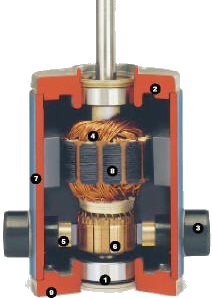DC Motor Calculations

Description
Calculate permenant magnet DC motor parameters (brush or brushless) using easily measured data; Voltage, Resistance, No-Load Speed, No-Load current etc.
Calculation Reference
DC Motor
To calculate the parameters of a permanent magnet DC (PMDC) motor, you need to consider the key electrical and mechanical specifications. Some common parameters include:
-
Motor voltage (V): The rated voltage at which the motor is designed to operate. This can be found on the motor's datasheet or nameplate.
-
Armature resistance (Ra): The resistance of the motor's armature winding, which can be measured using a multimeter or found on the motor's datasheet.
-
No-load current (Io): The current drawn by the motor when it is running at its rated voltage without any load (torque) applied. This value can be found on the motor's datasheet or can be measured using an ammeter.
-
Stall current (Is): The current drawn by the motor when it is stalled (not rotating) and subjected to its rated voltage. This value can be found on the motor's datasheet or can be calculated using Ohm's Law: Is = V / Ra.
-
No-load speed (ωo): The rotational speed of the motor when running at its rated voltage without any load (torque) applied. This value is typically given in RPM (revolutions per minute) and can be found on the motor's datasheet or measured with a tachometer.
-
Stall torque (Ts): The maximum torque the motor can produce when stalled (not rotating) and subjected to its rated voltage. This value can be found on the motor's datasheet.
-
Motor constant (Kt): The torque constant, which relates the motor's torque to the armature current. It can be calculated using the stall torque and stall current: Kt = Ts / Is. The motor constant is typically given in Nm/A or oz-in/A.
-
Motor constant (Ke): The back EMF constant, which relates the motor's back EMF to its rotational speed. Ke is usually equal to Kt (in SI units) for PMDC motors. The back EMF constant is typically given in V/rad/s or V/1000 RPM.
-
Motor efficiency (η): The ratio of the mechanical power output to the electrical power input, expressed as a percentage. To calculate the motor efficiency, you need to measure or calculate the motor's torque, speed, and input power at various operating points.
-
Power output (Pout): The mechanical power output of the motor, calculated as the product of torque and angular velocity (in radians per second): Pout = Torque * ω.
These are some of the key parameters of a PMDC motor. Depending on your specific application and requirements, you may need to consider additional parameters such as motor size, weight, and thermal characteristics. Always refer to the motor's datasheet for accurate and detailed specifications.
Calculation Preview
Full download access to any calculation is available to users with a paid or awarded subscription (XLC Pro).
Subscriptions are free to contributors to the site, alternatively they can be purchased.
Click here for information on subscriptions.

